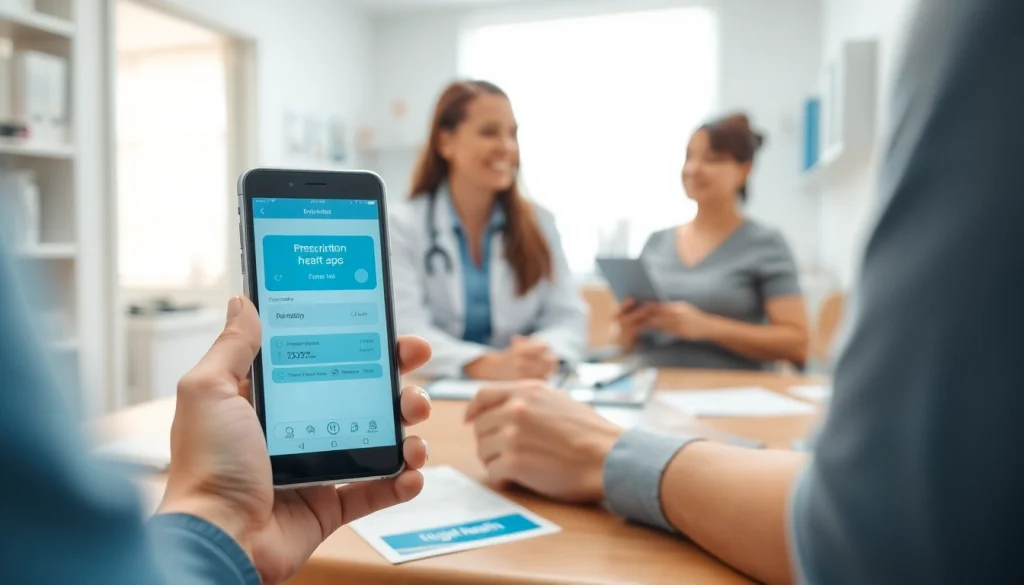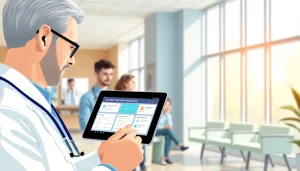
Understanding Eprescription Apps
Definition and Overview
Eprescription apps are digital tools that facilitate the electronic generation and transmission of prescriptions between healthcare providers, pharmacies, and patients. Instead of relying on handwritten prescriptions, these apps enable physicians to send prescriptions electronically to pharmacies directly from their devices, which enhances accuracy and security. The digital transition from paper to electronic prescriptions aims to streamline the prescribing process while offering a host of benefits to all parties involved. This innovation is part of a broader shift toward the digitalization of healthcare, offering solutions that can improve patient care and operational efficiency.
How Eprescription Apps Work
Eprescription apps leverage technology to allow physicians to input patient information, medication details, and dosage instructions into a secure digital framework. Once the prescription is finalized, it is sent directly to the pharmacy through a secure network, eliminating the need for physical paperwork. Patients also benefit, as they can access their prescriptions through mobile applications, which often include reminders and health tracking features. These apps typically integrate with electronic health record (EHR) systems, ensuring that patient data is accurate and up-to-date, while also significantly reducing the chances of human error associated with manual entries.
Importance of Technology in Healthcare
The integration of technology in healthcare is no longer optional but has become a necessity. As the healthcare landscape evolves, the quality of care increasingly hinges on efficient workflows, accessibility of information, and patient engagement. Eprescription apps support these elements by facilitating faster communication between patients and providers, ensuring data integrity while complying with regulatory standards. Additionally, technologies like Eprescription apps ensure that the healthcare system is better equipped to handle the demands of modern healthcare, such as managing chronic diseases and accommodating an aging population.
Advantages of Using Eprescription Apps
Improved Medication Adherence
One of the most significant advantages of using eprescription apps is that they help improve medication adherence among patients. Non-adherence can lead to serious health complications, increased hospitalizations, and soaring healthcare costs. Through features like medication reminders and refill notifications, eprescription apps encourage patients to take their medications as prescribed. Moreover, studies indicate that the digital tracking of medication schedules can bolster patient engagement, making it easier for individuals to follow their treatment regimens accurately.
Enhanced Communication Between Patients and Providers
Clear communication is vital in healthcare, and eprescription apps bridge gaps that often exist between patients and healthcare providers. By enabling direct communication channels, these apps allow patients to clarify prescription instructions easily and seek answers to queries without unnecessary delays. This two-way communication not only fosters trust between patients and providers but also empowers patients to take greater control over their health, ultimately leading to better outcomes.
Reduced Medication Errors
Medication errors are a significant concern in healthcare and can arise from various sources, including illegible handwriting, misunderstanding medication instructions, and the manual input of data. Eprescription apps effectively reduce these risks by automating the prescription process and incorporating decision-support tools that guide providers in selecting the appropriate medications and dosages. With drug interaction checks and allergy information built into the apps, the risk of critical errors is minimized, thus enhancing patient safety.
Challenges in Implementing Eprescription Apps
Technological Barriers
Despite the clear advantages of using eprescription apps, certain technological barriers can hamper their wide-scale implementation. Issues such as inadequate internet connectivity in rural areas or limited access to devices among some populations can pose challenges. Healthcare providers may also encounter difficulties when integrating these apps into existing systems, particularly if they’re transitioning from largely manual workflows. Addressing these barriers will require collaborative efforts between technology providers and the healthcare industry to ensure seamless integration and accessibility across various demographics.
Patient Resistance to Change
Change is often met with resistance, and the adoption of eprescription apps is no exception. Some patients may feel uncomfortable with technology or prefer traditional methods of communication with their healthcare providers. Overcoming this resistance necessitates proactive engagement strategies that educate patients on the benefits of using these apps, including how they can improve their health management. Adequate training sessions and demonstrations can also alleviate fears and enhance users’ confidence in adopting new digital healthcare solutions.
Regulatory Considerations
Healthcare regulations and compliance requirements can pose challenges to the adoption of eprescription apps. Providers must navigate a complex landscape of regulations that govern electronic health records, patient data privacy, and telehealth practices. Moreover, different states may have varying laws regarding the use of electronic prescriptions. Ensuring compliance with these regulations is critical, as any violations can result in significant penalties. It is essential for healthcare organizations to work closely with legal and compliance experts when implementing new technologies to avoid pitfalls.
Best Practices for Utilizing Eprescription Apps
Educating Patients
Effective education is crucial for maximizing the benefits of eprescription apps. Healthcare providers should proactively inform patients about how to use the apps, ensuring they understand features such as medication tracking, refill requests, and communication channels. Workshops, one-on-one training, or educational materials can significantly enhance patient understanding and acceptance of these tools, ultimately leading to greater engagement and improved health outcomes.
Integrating Eprescription into Daily Workflow
The successful integration of eprescription apps into a healthcare provider’s daily workflow is essential for maximizing efficiency. Providers should aim to streamline the process by incorporating the use of these apps within routine tasks. For example, integrating eprescription directly into patient consultation software can minimize disruptions and enhance workflow efficiency. Furthermore, establishing clear protocols for when and how to use the apps helps ensure that all staff members are aligned and can utilize the technology effectively.
Monitoring and Evaluating App Effectiveness
Monitoring and evaluating the effectiveness of eprescription apps is vital to ensure they deliver their intended benefits. Healthcare organizations should employ performance metrics to gauge the impact of the apps on medication adherence, error reduction, and patient satisfaction. Gathering feedback from users can also provide invaluable insights, allowing for ongoing improvements in the apps’ functionality. By continuously refining app usage through monitoring and evaluation, organizations can significantly enhance patient care and outcomes.
Future Trends in Eprescription Technology
Integration with AI and Machine Learning
As technology continues to evolve, the integration of artificial intelligence (AI) and machine learning into eprescription apps is expected to transform how prescriptions are managed. These technologies can analyze patient data to personalize medication regimens based on individual health profiles and treatment histories. Additionally, AI can enhance decision-making processes by predicting potential adverse drug interactions or identifying alternative medications that may be more effective.
The Role of Telemedicine
Telemedicine is rapidly gaining ground as a vital component of healthcare, and eprescription apps are poised to play a crucial role in this paradigm shift. As more healthcare services are delivered remotely, the ability to prescribe medications digitally is increasingly essential. Eprescription apps provide seamless support for telemedicine consultations, ensuring that prescriptions can be generated and sent without delays, thus maintaining the continuity of care for patients who may not have access to in-person visits.
Potential for Improved Health Outcomes
With the ongoing development of eprescription technology, there is significant potential for improved health outcomes for patients. As these apps evolve to become more user-friendly and integrated into daily healthcare practices, they could help address many of the current challenges faced within the healthcare system, such as medication non-adherence and communication lapses. The use of eprescription apps that are tailored to specific patient demographics can also lead to better monitoring and management of chronic conditions, ultimately enhancing the quality of care provided.






